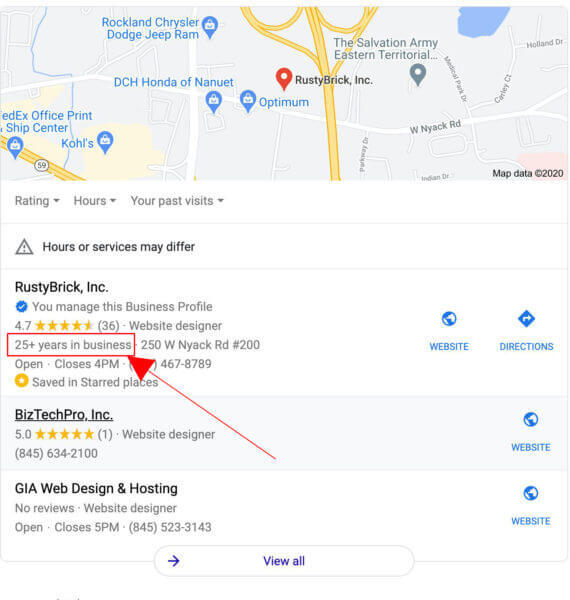Damian Rollison | Feb 15, 2021 3:04:47 AM
6 Min Read
This week, learn about the launch of GMB messaging for desktop; why E-A-T is important for local SEO; years in business in the local pack; Google’s rollout of passage ranking; SEO tips and tricks for images; and using keyword research across the enterprise.
Google is bringing messaging to the desktop version of the Google My Business dashboard. The GMB messaging help page now states that all businesses will have access to messaging on the web by early March 2021. To enable messaging, businesses must visit the Messages tab in the GMB dashboard and turn the feature on. You can add an initial message that will be sent to all customers as an autoreply, and anyone who has access to manage the listing can respond to messages.
Google may turn off the messaging feature if businesses habitually fail to respond to messages within 24 hours. Apparently, if Google does turn the feature off, you can simply turn it on again in your dashboard settings. Illegitimate messages can be marked as spam, and if so marked will not count against the business in the response time calculation. You can also block individual users from messaging your business.
Businesses in certain categories will see “Get a Quote” or “Request a Booking” buttons appear in their business profiles when messaging is enabled; clicking the button initiates a messaging session.

New “Computer” section in messaging help page, per Search Engine Journal
Andrew Shotland has a post on the Local SEO Guide blog discussing the importance of E-A-T for local SEO. As you probably know, E-A-T stands for “expertise, authoritativeness, and trustworthiness,” and is an umbrella term for the criteria by which Google assesses website content for ranking purposes. E-A-T is especially important in so-called YMYL (“your money or your life”) categories like health and finance where expertise, authority, and trust are critical.
For SEO in general, E-A-T recommendations include publishing up-to-date, accurate content created by experts in your field; getting positive reviews of your content; and linking to sources that back up your content and bolster the credibility of your content authors.
Local SEO is, of course, about optimizing the relevance and prominence of your local business as these qualities are viewed by Google’s local algorithms. This can be done, Shotland says, by applying E-A-T principles across features like primary and secondary categories, Google Posts, content on your website, GMB images, structured data, and presence on local and national directories. Positive reviews, Shotland notes, are also critical to building authority. Shotland’s argument is that trust signals in a local context consist of providing your potential customer with information that reinforces your relevance and prominence in searches.
For some businesses, Google is now displaying the number of years in business as an attribute in the local pack. Qualifying businesses can enable this feature by adding an opening date to their business profiles in the GMB dashboard. The reference appears on the same line as the business address. The feature has been live from some businesses as far back as September 2020, though Google only announced it on February 9. We’ve just been discussing E-A-T and local SEO, and it makes sense to assume that businesses with a longer history are more likely to be judged as having expertise and authority in consumers’ eyes.

Image courtesy Search Engine Land
Google went live with the long-awaited passage ranking update on February 10, as confirmed on Twitter by Danny Sullivan. This update, signalled by Google back in October, provides the ability to rank specific passages on a web page for the topic that passage covers, whereas other passages might be ranked for different search terms. Google predicted in October that the passage ranking update would impact 7% of all search queries, which by volume is a huge number since Google handles an estimated 5.6 billion queries every day. In his writeup on Search Engine Roundtable, Barry Schwartz notes that the update had little impact on rankings. He has also published a long list of articles discussing the update.
Google’s John Mueller has published a ten-minute video that discusses SEO tips and tricks for images. Mueller offers twelve tips in total, paraphrased from Barry Schwartz below:
(1) Images should be relevant to the page, and titles, headings, and content should be relevant to the image
(2) Place images near relevant text and provide captions near the image; place your most important images at the top
(3) Don't embed text in the image; place that text on the page
(4) Use alt attributes on your images
(5) Use high quality images
(6) Make high quality sites
(7) Create mobile and desktop friendly sites
(8) Use good descriptive urls; Google uses both the URL path and image file name for understanding the image; avoid changing the URL and if you do change it, 301 the old URL to the new one
(9) Provide relevant structured data on your pages
(10) Use large image previews using max-image-preview-large
(11) Add image licensing markup
(12) Speed up your pages by optimizing image size, lazy loading techniques, and more
Mark Traphagen of seoClarity has an interesting post in Search Engine Journal about the usefulness of SEO keyword research in departments outside of SEO. Traphagen says that content marketing, PPC, product, and even executive team members can benefit from an understanding of keyword research and its results.
Content teams might be the most obvious beneficiaries, since quality website content is such an important focus of Google’s current ranking methodology. “Your site’s high-ranking keywords,” Traphagen writes, “are good targets for topic clustering, building content that is topically related to those keywords, then interlinking all of that quality content.”
PPC teams, Traphagen argues, can glean valuable insights from SEO keyword research about the intent behind search queries. They can also learn about keywords the brand is already performing well for organically, as well as those where paid efforts would yield the greatest benefits.
Product teams can benefit from keyword research by gaining market intelligence about the keywords that bring searchers to their products and services. Market executives can learn from keyword analysis about strategically important consumer signals such as seasonal demand for certain products and services.
Topics: Monday Memo

VP of Market Development and Strategic Partnerships
Offer Post Justifications Spotted in Local Results
Oct 4, 2021 8:47:46 AM
Monday Memo: More than Brands and Influencers, Consumers Trust Each Other
Sep 27, 2021 7:56:34 AM
Monday Memo: Google Adds “Latino-Owned” to GMB Identity Attributes
Sep 20, 2021 7:58:58 AM
Monday Memo: New Study Shows 94% of Consumers Use Online Business Directories
Sep 13, 2021 7:16:55 AM
Monday Memo: The Page Experience Update Has Fully Rolled Out
Sep 6, 2021 7:43:45 AM